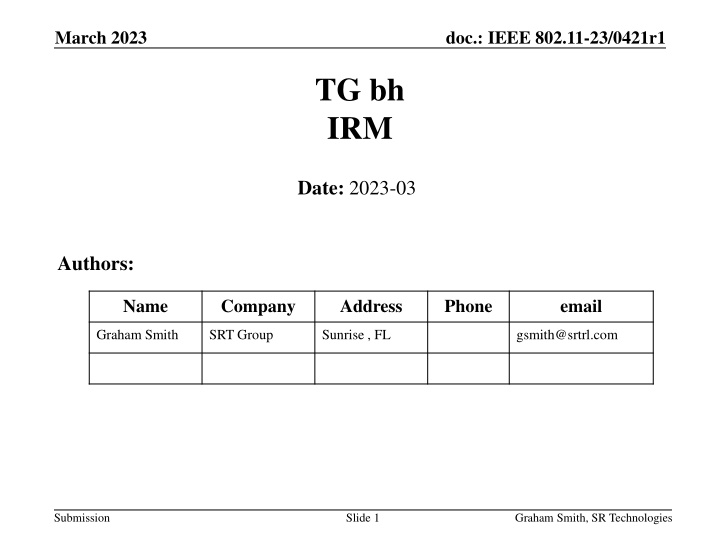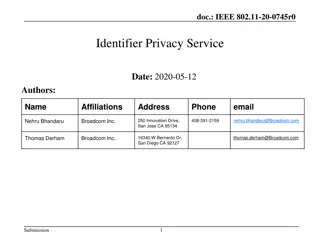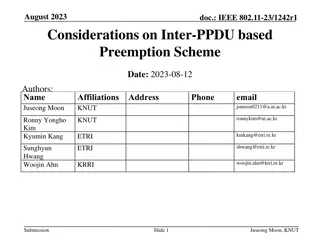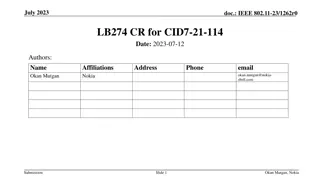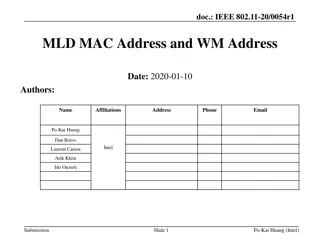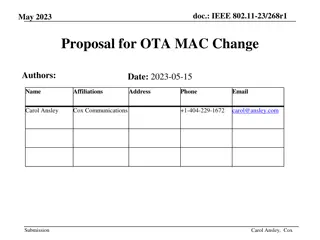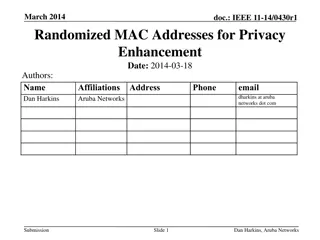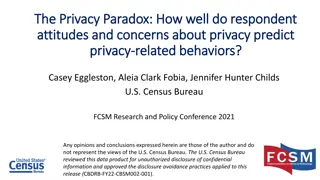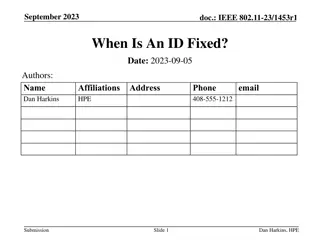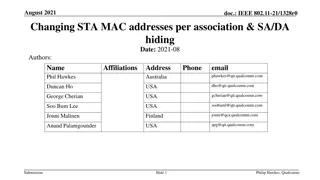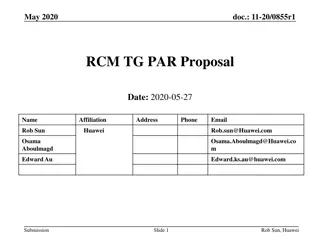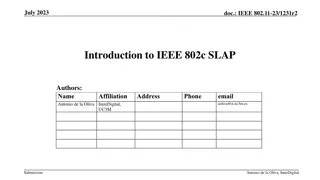IEEE 802.11-23/0421r1: Understanding the IRM Scheme for MAC Address Privacy
The document discusses the use of the Same MAC Address (SMA) scheme in IEEE 802.11-23/0421r1 and introduces the Improved Randomized MAC (IRM) scheme as a privacy-enhancing solution. It explores the implementation and benefits of IRM over SMA, addressing issues like privacy requirements, device identification, and the use of opaque IDs. The IRM scheme simplifies address management, eliminates the need for complex computations, and ensures compatibility with existing use cases.
Download Presentation

Please find below an Image/Link to download the presentation.
The content on the website is provided AS IS for your information and personal use only. It may not be sold, licensed, or shared on other websites without obtaining consent from the author.If you encounter any issues during the download, it is possible that the publisher has removed the file from their server.
You are allowed to download the files provided on this website for personal or commercial use, subject to the condition that they are used lawfully. All files are the property of their respective owners.
The content on the website is provided AS IS for your information and personal use only. It may not be sold, licensed, or shared on other websites without obtaining consent from the author.
E N D
Presentation Transcript
March 2023 doc.: IEEE 802.11-23/0421r1 TG bh IRM Date: 2023-03 Authors: Name Company Address Phone email Graham Smith SRT Group Sunrise , FL gsmith@srtrl.com Submission Slide 1 Graham Smith, SR Technologies
March 2023 doc.: IEEE 802.11-23/0421r1 Intro The default scheme in use is Same MAC Address (SMA) When a STA returns to a network it uses the same MAC Address each time. Problem is that the copying of the address is simple, and this possibly does not meet our privacy requirement. Submission Slide 2 Graham Smith, SR Technologies
March 2023 doc.: IEEE 802.11-23/0421r1 IRM cf SMA IRM scheme is: STA provides a (random) MAC Address to the AP/ESS in each association (msg 2) STA uses that address in the next association. One step further to SMA, (STA controls) Simple, NO computations STA controls the MAC Address (same as SMA) STA remembers address in same manner as SMA Meets all use cases Complements Device ID STA identified early (returning STA), then ID can be used Submission Slide 3 Graham Smith, SR Technologies
March 2023 doc.: IEEE 802.11-23/0421r1 IE/ID method(s) STA adds new IE (to association request) which includes an ID Different ID to Device ID Device ID can be fixed, but IE/ID must change every association STA and AP need to keep them separate - Device ID/IEID What rules are required (look how Device ID grew) What length? If not defined and fixed length, then is a simple fingerprint. How long? 6 octets for uniqueness? Why add a new IE? (What is advantage over IRM? ) Further divorced from SMA. Submission Slide 4 Graham Smith, SR Technologies
March 2023 doc.: IEEE 802.11-23/0421r1 Opaque ID in IE Opaque ID tends to be long, How it may be used in IE has not been defined Same comments as IE/ID on previous slide. Requires computations on AP side. Not sure if STA needs also to carry out computations. Submission Slide 5 Graham Smith, SR Technologies
March 2023 doc.: IEEE 802.11-23/0421r1 Why IRM? IRM is one step beyond SMA - very much a TGbh solution No extra work required for STA cf SMA (one address stored per network) No extra work required for AP cf SMA (one address stored per STA) Simple, NO computations simpler the solution the better the chance to be implemented Satisfies all Use Cases Option to allow say 2 Addresses, but not required (from discussions). Complements Device ID No new IE required (avoid fingerprint) - efficient Need not use a capability bit (reduce fingerprint) Note SMA does not use a capability bit. Text in 23/0129r0 Slide 6 Submission Graham Smith, SR Technologies
March 2023 doc.: IEEE 802.11-23/0421r1 Conclusion IRM ticks all the boxes for a TGbh solution. Submission Slide 7 Graham Smith, SR Technologies
